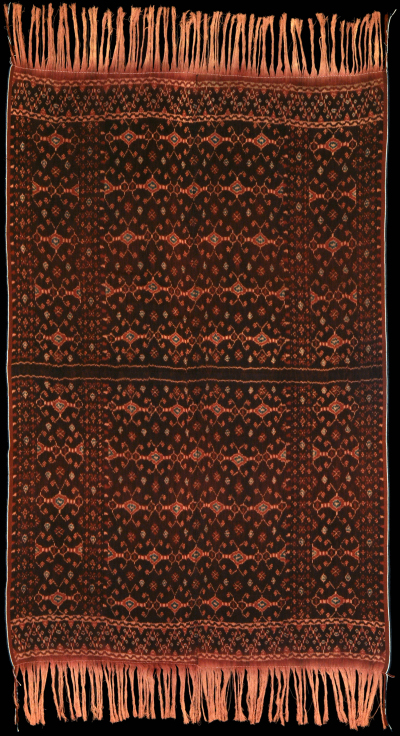| |
 
 | | | |
084 Flores Group, Ndona
Semba (man's shawl)  
| | Locale: | Village not identified. | | Period: | 1930-1945 | | Yarn: | Cotton, hand-spun, fine, double-ply | | Technique: | Warp ikat | | Panels: | 2 | | Size: | 113 x 169 cm (3' 8" x 5' 6") LW: 1.50 | | Design: | Patola-like field with ten rows of six jilamprang motifs, tumpal end borders. Executed in dark and lighter morinda red with accents - such as the cores of the jilamprang motifs - in fairly light indigo. Overall tone chestnut, tending to russet. | | Comment: | Excellent and substantial older Ndona cloth in immaculate state of preservation. Note the lateral borders, which in neighbouring Ende stopped being made around 1930, but in more conservative Ndona remained part of the canon. | | Background: | Chapters on Flores Group and Ndona. | | Exhibited: | Museu do Oriente, Lisbon, 2014/15.
Hong Kong University Museum and Art Gallery, 2017. | | Published: | Woven Languages, 2014.
Ikat Textiles of the Indonesian Archipelago, 2018.
| | Compare: | 083 090 | | Sources: | Similar to cloth depicted in Khan Majlis, Woven Messages, Fig. 167, identified as Endeh (Ende). It was almost certainly made in the Endenese part of Ndona. Also similar to one depicted in Hamilton's contribution to semba in Nabholz-Kartaschoff, Weaving Patterns of Life, Fig. 4, and to one in Hamilton, Gift of the Cotton Maiden, Fig. 6-21. | | |

©Peter ten Hoopen, 2025
All rights reserved.
|
|


